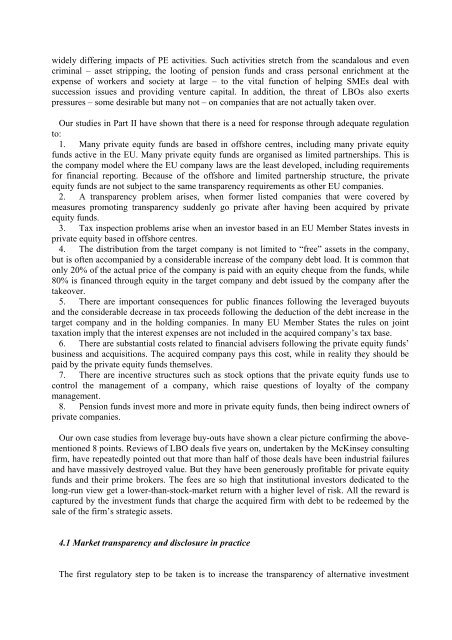Executive summary - Udo Bullmann
Executive summary - Udo Bullmann
Executive summary - Udo Bullmann
- No tags were found...
You also want an ePaper? Increase the reach of your titles
YUMPU automatically turns print PDFs into web optimized ePapers that Google loves.
widely differing impacts of PE activities. Such activities stretch from the scandalous and evencriminal – asset stripping, the looting of pension funds and crass personal enrichment at theexpense of workers and society at large – to the vital function of helping SMEs deal withsuccession issues and providing venture capital. In addition, the threat of LBOs also exertspressures – some desirable but many not – on companies that are not actually taken over.Our studies in Part II have shown that there is a need for response through adequate regulationto:1. Many private equity funds are based in offshore centres, including many private equityfunds active in the EU. Many private equity funds are organised as limited partnerships. This isthe company model where the EU company laws are the least developed, including requirementsfor financial reporting. Because of the offshore and limited partnership structure, the privateequity funds are not subject to the same transparency requirements as other EU companies.2. A transparency problem arises, when former listed companies that were covered bymeasures promoting transparency suddenly go private after having been acquired by privateequity funds.3. Tax inspection problems arise when an investor based in an EU Member States invests inprivate equity based in offshore centres.4. The distribution from the target company is not limited to “free” assets in the company,but is often accompanied by a considerable increase of the company debt load. It is common thatonly 20% of the actual price of the company is paid with an equity cheque from the funds, while80% is financed through equity in the target company and debt issued by the company after thetakeover.5. There are important consequences for public finances following the leveraged buyoutsand the considerable decrease in tax proceeds following the deduction of the debt increase in thetarget company and in the holding companies. In many EU Member States the rules on jointtaxation imply that the interest expenses are not included in the acquired company’s tax base.6. There are substantial costs related to financial advisers following the private equity funds’business and acquisitions. The acquired company pays this cost, while in reality they should bepaid by the private equity funds themselves.7. There are incentive structures such as stock options that the private equity funds use tocontrol the management of a company, which raise questions of loyalty of the companymanagement.8. Pension funds invest more and more in private equity funds, then being indirect owners ofprivate companies.Our own case studies from leverage buy-outs have shown a clear picture confirming the abovementioned8 points. Reviews of LBO deals five years on, undertaken by the McKinsey consultingfirm, have repeatedly pointed out that more than half of those deals have been industrial failuresand have massively destroyed value. But they have been generously profitable for private equityfunds and their prime brokers. The fees are so high that institutional investors dedicated to thelong-run view get a lower-than-stock-market return with a higher level of risk. All the reward iscaptured by the investment funds that charge the acquired firm with debt to be redeemed by thesale of the firm’s strategic assets.4.1 Market transparency and disclosure in practiceThe first regulatory step to be taken is to increase the transparency of alternative investment





